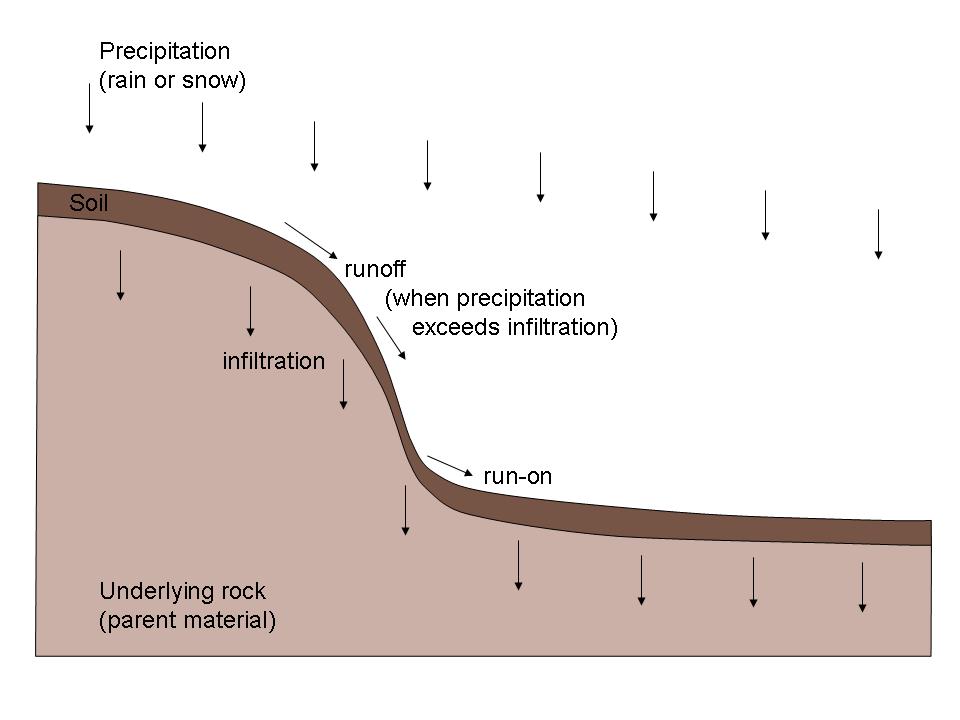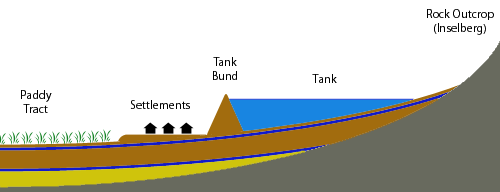Catena (soil) on:
[Wikipedia]
[Google]
[Amazon]
 A catena in
A catena in

 A catena forms when the climate, including precipitation and evaporation, is the same for the whole slope, and when sufficient time has passed for equilibrium to be reached between the processes that bring materials in to a facet and the processes that take materials away. The result is a predictable sequence of soil facets.Schaetzl, 2005. pp. 469-474. A catena is thus an open system which has continuous input and output processes. On a steeper slope in the middle of a catena, erosion (
A catena forms when the climate, including precipitation and evaporation, is the same for the whole slope, and when sufficient time has passed for equilibrium to be reached between the processes that bring materials in to a facet and the processes that take materials away. The result is a predictable sequence of soil facets.Schaetzl, 2005. pp. 469-474. A catena is thus an open system which has continuous input and output processes. On a steeper slope in the middle of a catena, erosion (
 A catena in
A catena in soil science
Soil science is the study of soil as a natural resource on the surface of the Earth including soil formation, soil classification, classification and Soil survey, mapping; Soil physics, physical, Soil chemistry, chemical, Soil biology, biologica ...
(pedology
Pedology (from Greek: πέδον, ''pedon'', "soil"; and λόγος, ''logos'', "study") is a discipline within soil science which focuses on understanding and characterizing soil formation, evolution, and the theoretical frameworks for modelin ...
) is a series of distinct but co-evolving soils
Soil, also commonly referred to as earth, is a mixture of organic matter, minerals, gases, water, and organisms that together support the life of plants and soil organisms. Some scientific definitions distinguish dirt from ''soil'' by restri ...
arrayed down a slope. Each soil type or "facet" differs somewhat from its neighbours, but all occur in the same climate and on the same underlying parent material
Parent material is the underlying geological material (generally bedrock or a superficial deposits, superficial or drift (geology), drift deposit) in which soil horizons form. Soils typically inherit a great deal of structure and minerals from th ...
. A mature catena is in equilibrium as the processes of deposition and erosion
Erosion is the action of surface processes (such as Surface runoff, water flow or wind) that removes soil, Rock (geology), rock, or dissolved material from one location on the Earth's crust#Crust, Earth's crust and then sediment transport, tran ...
are in balance.
Concept
The term soil catena is used to describe the lateral variation in soils over a hillslope. The catena concept originated in centralUganda
Uganda, officially the Republic of Uganda, is a landlocked country in East Africa. It is bordered to the east by Kenya, to the north by South Sudan, to the west by the Democratic Republic of the Congo, to the south-west by Rwanda, and to the ...
by chemist W.S. Martin to describe a hill slope sequence at the Bukalasa research station. The term catena (Latin: chain) was first coined by scientist Geoffrey Milne to describe these soil-topography units.
The concept was developed in order to analyze the regular variation of soils across a slope. The example of this approach consists first in a structural component, the recurring pattern of certain soils in a landscape transect in which every chain element has its place in the chain, a soil has it in a landscape.
Formation
A slope can be broken into sections known as aridge
A ridge is a long, narrow, elevated geomorphologic landform, structural feature, or a combination of both separated from the surrounding terrain by steep sides. The sides of a ridge slope away from a narrow top, the crest or ridgecrest, wi ...
, crest, midslope, and toeslope. The ridge or hilltop tends to accumulate organic matter that allows formation of an adequate thickness of soil. Steeper slope or crest sections tend to be freely drained, while at the bottom of slopes or toeslopes there is usually higher in moisture content and poor drainage. Toeslope soils are also known to be richer in clay and organic matter.Birkeland, P.W., 1984. ''Soils and Geomorphology''. Oxford University Press, NY.
Lithology
The lithology of a rock unit is a description of its physical characteristics visible at outcrop, in hand or core samples, or with low magnification microscopy. Physical characteristics include colour, texture, grain size, and composition. Lit ...
and relief
Relief is a sculpture, sculptural method in which the sculpted pieces remain attached to a solid background of the same material. The term ''wikt:relief, relief'' is from the Latin verb , to raise (). To create a sculpture in relief is to give ...
can be the primary controls on the development of certain catenas with easily disaggregated parent rock
In the earth sciences, parent rock, also sometimes ''substratum'', is the original rock from which younger rock or soil is formed. In soil formation, the parent rock (or parent material) normally has a large influence on the nature of the resultin ...
and high relief favoring particle redistribution and therefore the formation of distinct soils in particle-source and particle-deposition zones along a slope.Sommer, M., Halm, D., Weller, U., Zarei, M., Stahr, K., 2000. "Lateral podzolization in a granite landscape". ''Soil Science Society of America Journal'' 64 (6), 2000. . Catenas can also develop on low relief hillslopes, but because less potential energy is available, the redistribution of mass can be dominated by subsurface flow of plasma, a combination of dissolved and suspended solids in soil water.Nettleton, W.D., Flach, K.W., Borst, G., 1968. ''A toposequence of soils in tonalite grus in the Southern California Peninsular Range''. Soil Survey Investigations Report No. 21. Soil Conservations Service, Washington DC.
Open system

 A catena forms when the climate, including precipitation and evaporation, is the same for the whole slope, and when sufficient time has passed for equilibrium to be reached between the processes that bring materials in to a facet and the processes that take materials away. The result is a predictable sequence of soil facets.Schaetzl, 2005. pp. 469-474. A catena is thus an open system which has continuous input and output processes. On a steeper slope in the middle of a catena, erosion (
A catena forms when the climate, including precipitation and evaporation, is the same for the whole slope, and when sufficient time has passed for equilibrium to be reached between the processes that bring materials in to a facet and the processes that take materials away. The result is a predictable sequence of soil facets.Schaetzl, 2005. pp. 469-474. A catena is thus an open system which has continuous input and output processes. On a steeper slope in the middle of a catena, erosion (surface runoff
Surface runoff (also known as overland flow or terrestrial runoff) is the unconfined flow of water over the ground surface, in contrast to ''channel runoff'' (or ''stream flow''). It occurs when excess rainwater, stormwater, meltwater, or other ...
) is faster, so facets are typically thinner and drier. Conversely, on a shallower slope at the top or bottom of a catena, soils are thicker and deeper. In addition, the top facets lose materials such as mineral salts when these are washed out by rain ( eluviation), while the bottom facets gain materials when these are washed in (illuviation
Illuvium is material displaced across a soil profile, from one layer to another one, by the action of rainwater. The removal of material from a soil layer is called eluviation. The transport of the material may be either mechanical or chemical. ...
).Waugh, 2000. p. 276.
A catena can form on various underlying or parent materials and in different climates. On impermeable acid rocks such as metamorphic schist
Schist ( ) is a medium-grained metamorphic rock generally derived from fine-grained sedimentary rock, like shale. It shows pronounced ''schistosity'' (named for the rock). This means that the rock is composed of mineral grains easily seen with a l ...
s in a high rainfall climate like that of western Scotland
Scotland is a Countries of the United Kingdom, country that is part of the United Kingdom. It contains nearly one-third of the United Kingdom's land area, consisting of the northern part of the island of Great Britain and more than 790 adjac ...
, the catena consists of thick acidic peat
Peat is an accumulation of partially Decomposition, decayed vegetation or organic matter. It is unique to natural areas called peatlands, bogs, mires, Moorland, moors, or muskegs. ''Sphagnum'' moss, also called peat moss, is one of the most ...
-forming wet bog
A bog or bogland is a wetland that accumulates peat as a deposit of dead plant materials often mosses, typically sphagnum moss. It is one of the four main types of wetlands. Other names for bogs include mire, mosses, quagmire, and musk ...
on the flatter facets, and thinner, drier, somewhat less acidic peaty podsol
Podzols, also known as podosols, spodosols, or espodossolos, are the typical soils of coniferous or Taiga, boreal forests and also the typical soils of eucalypt forests and heathlands in southern Australia. In Western Europe, podzols develop on he ...
s on the steeper facets. Thus the soil depth, acidity ( pH), and soil moisture
Soil moisture is the water content of the soil. It can be expressed in terms of volume or weight. Soil moisture measurement can be based on ''in situ'' probes (e.g., capacitance probes, neutron probes) or remote sensing methods.
Water that enters ...
vary continuously along the slope. On a permeable basic rock such as chalk
Chalk is a soft, white, porous, sedimentary carbonate rock. It is a form of limestone composed of the mineral calcite and originally formed deep under the sea by the compression of microscopic plankton that had settled to the sea floor. Ch ...
, the catena may consist of thick brown earth
Brown earth is a type of soil. Brown earths are mostly located between 35° and 55° north of the Equator. The largest expanses cover western and central Europe, large areas of western and trans-Uralian Russia, the east coast of America and easte ...
s on the flatter facets, with thin rendzinas on the steeper slopes, while the valley bottom may include alkaline fen
A fen is a type of peat-accumulating wetland fed by mineral-rich ground or surface water. It is one of the main types of wetland along with marshes, swamps, and bogs. Bogs and fens, both peat-forming ecosystems, are also known as mires ...
peat or river alluvium
Alluvium (, ) is loose clay, silt, sand, or gravel that has been deposited by running water in a stream bed, on a floodplain, in an alluvial fan or beach, or in similar settings. Alluvium is also sometimes called alluvial deposit. Alluvium is ...
.
References
Bibliography
* * * * {{cite book , title=Geography: An Integrated Approach , publisher=Nelson Thornes , author=Waugh, David , year=2000 , page=276 , isbn=9780174447061 , url=https://books.google.com/books?id=7GH0KZZthGoC&pg=PA276 Types of soil Geomorphology Soil science Pedology